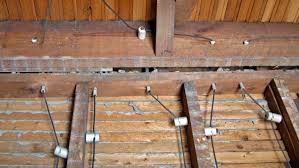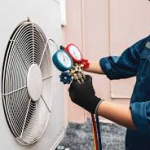The foundation of every safe and efficient home begins behind the walls—where wires carry power to lights, appliances, and outlets. In older homes, however, these wiring systems often date back several decades and can pose significant safety risks. One of the most outdated and problematic systems is knob-and-tube wiring, which was common in homes built before the 1950s. As families modernize their lifestyles with advanced electronics, air conditioning systems, and high-powered kitchen appliances, the strain on outdated wiring becomes increasingly dangerous.
Replacing this system isn’t just a matter of convenience—it’s a matter of safety and peace of mind. We will explore how transitioning from knob-and-tube to modern wiring can dramatically improve a home’s safety and functionality, and how the electrician approaches this vital process with a clear, step-by-step strategy that prioritizes safety, compliance, and customer satisfaction.
Why Knob-and-Tube Wiring No Longer Meets Today’s Demands
Knob-and-tube wiring was an innovative solution when it was introduced in the late 19th century. Using ceramic knobs to suspend wires and tubes to protect them as they passed through wooden structures, this system worked well for the limited electrical demands of early households. However, today’s homes are vastly different environments. Modern appliances, home office setups, and digital devices draw significantly more power than a system like knob-and-tube can reliably handle. One of the biggest risks with this outdated system is the lack of grounding. Modern wiring includes a ground wire that helps protect against electric shock and fire hazards. Knob-and-tube wiring does not, leaving homeowners more vulnerable to these risks.
Additionally, the insulation surrounding these wires often degrades over time, especially when subjected to heat, making it a major fire hazard. Insurance companies increasingly refuse to insure homes with active knob-and-tube wiring, pushing homeowners to reconsider their electrical infrastructure. Delaware County electricians understand these risks and approach rewiring not just as a technical job, but as a safeguard for families and their property.
The Evaluation: Assessing the Electrical Landscape of Older Homes
The first stage of any safe rewiring process begins with a thorough inspection of the home’s current electrical system. This involves tracing existing circuits, identifying any remaining knob-and-tube installations, and evaluating the condition of outlets, junction boxes, and service panels. Homes with partial updates—where knob-and-tube wiring has been mixed with newer systems—present a unique challenge. These mixed installations can lead to overloaded circuits and hidden risks if not properly documented or installed.
JDV Electric’s team carefully maps out all wiring paths, determines the load each circuit should carry, and checks for code violations or deteriorated components. This upfront diligence is crucial. It ensures that the rewiring process not only removes outdated elements but also enhances the home’s long-term electrical performance. Homeowners are kept fully informed throughout the evaluation, allowing them to understand what needs to be done, why it’s necessary, and how it will be implemented with minimal disruption.
Planning the Upgrade: Strategic Steps Toward Safer, Smarter Wiring
Once the evaluation is complete, the focus shifts to planning the new electrical layout. This includes designing circuits to handle current and future energy demands, ensuring even distribution of load, and integrating modern safety features like ground fault circuit interrupters (GFCIs) and arc fault circuit interrupters (AFCIs). A common misconception is that rewiring always requires tearing out walls and causing major structural damage. However, JDV Electric uses techniques that allow access to wiring paths with minimal disruption to the home’s interior. Strategic drilling, fishing wires through attics and crawlspaces, and careful routing allow for a cleaner, more efficient installation process.
In addition to improving safety, the new system is tailored to modern needs—adding more outlets, upgrading the service panel to accommodate additional circuits, and ensuring each room has appropriate access to power. Planning also includes scheduling work to limit interference with the homeowner’s routine, demonstrating a respect for both property and lifestyle throughout the process.
read more : Types of Businesses That Benefit Most from Copier Rental
Installation in Action: Precision, Safety, and Code Compliance
Rewiring a home is a major undertaking, but it doesn’t have to be overwhelming. During installation, the old knob-and-tube system is carefully removed or decommissioned to prevent future issues. Every wire that’s installed follows current National Electrical Code (NEC) guidelines, and additional safeguards are included where necessary. The electrician prioritizes proper grounding, secure connections, and correctly sized wiring to prevent overheating. They also focus on labeling every circuit clearly at the breaker panel to simplify and improve the safety of future maintenance.
Attention to detail during installation is key. Loose connections, poorly secured wires, or improper routing can all result in safety hazards in the long run. Each step of the process is double-checked before moving forward, and homeowners are encouraged to ask questions or review progress along the way. When installation is complete, a final inspection ensures everything is working as expected and fully compliant with local regulations. The end result is a safe, modern electrical system built to last for decades.
Upgrading from knob-and-tube wiring to a modern electrical system is one of the most impactful improvements a homeowner can make, both for safety and for everyday function. While the process may seem complex, working with a company that prioritizes clear communication, thorough evaluation, and careful installation makes it entirely manageable. JDV Electric approaches each rewiring project with a structured plan that respects the uniqueness of every home and the concerns of every homeowner. By focusing on long-term safety and performance, their process ensures peace of mind while preparing the home for modern demands.


